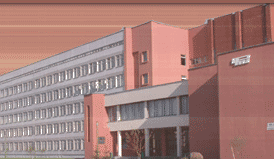|
The Physical
Technical Institute of the National Academy of
Sciences of Belarus (the PTI NAS Belarus) was
founded in 1932. About 370 people work for the
Institute at the moment.
The PTI NAS Belarus
conducts fundamental researches in the fields of
the plasticity and durability theory, phase and
structure conversion in metals and alloys,
thermal physics, pulse and electric physical
methods of metal treatment; the Institute
develops new processes for receiving and
treating machine-building materials and
products.
|
CWR Mill
CWR
Scheme
CWR
Process
CWR Tool
| |
The
development of theoretical basis for the
cross-wedge rolling (CWR) process and creation
of new technologies, equipment, and tools for
their realization are the main activity of the
Department of Technological Deformability. The
head of the department from the moment of its
foundation is Dr. Schukin. School which was
created by him is known as the leading in the
world. Here the classical theory of the
cross-wedge rolling is developed. The Department
conducts the fundamental and applied researches
the goal of which is the solving of a scientific
problem of augmentation of the effectiveness of
the Metal Pressure Treatment at the expenses of
more complete usage of plastic metal properties.
30% of the inventions belong to the Institute,
50% of the CWR equipment in the world is
produced in Belarus. More than 100 items of
rolling equipment of different modifications
sold in the CIS and Western countries. The
Belarusian equipment works in Russia, the
Ukraine, Bulgaria, the Czech Republic, Germany,
Spain, the USA, Poland, and Turkey. One rolling
mill of the Institute construction stands for 5
items of lathes and saves at the two-shift work
up to 800 tons of metal per year. The mill
begins to get profit in less than a
year.
Cross-wedge rolling (CWR) is a
high-performance resource-saving technology of
metal pressure processing with operating ratio
of metal utilization (RMU) 0.8-0.98. One can
produce with the help of the CWR method such
details as solids of revolution with the
lengthened axis, shaping of which is carried out
by redistribution of metal along an axis of
preform with flat wedge tool driven across the
axis. The configuration of details is rather
versatile: with cylindrical, conical and nodular
surfaces with every possible grooves and ledges.
Received details have peculiar features of high
resistance and wearability while in service.
With the help of the CWR method can be treated practically all
constructional steels, as well as yellow metal, titanium, zirconium and nickel.
DESCRIPTION OF THE TECHNOLOGICAL
PROCESS
With the help of the mechanism of
transition a blank is fed into the working cage
of the mill and is laid across the starting part
of the wedge tool. At the straight stroke of the
mill’s upper plate the billet is rolled between
movable upper and unmovable lower wedge tools.
The both tools have side inclined edges that
make the metal surplus move to butts in that way
lengthening the blank. The rest metal part is
rolled between the tools.
At the final stage
of forming the knives on the both sides of the
tools cut edge waste from the finally formed
part. It slithers into the receiving cage. The
movable tool goes to the starting
position.
ADVANTAGES OF CWR PROCESS
Out of well-known basic CWR schemes mostly wide-spread are flat-wedge and roller rolling on the basis of which appropriate kinds of equipment have been designed.The advantages and disadvantages of each kind have been revealed while in service.
To disadvantages of roller mills should be referred complexity and high labour input of manufacturing of roller tool engraving which is carried out on special lathes. The subsequent heat treatment does not provide the hardness corresponding to hardness of a flat tool. As a result, the resistance of a roller tool is lower than the flat tool’s resistance. Besides, turning processing of an engraving provides its lower accuracy in comparison with a polished engraving of a flat tool, and that leads to reduction of rolled parts’ accuracy.
Flat rolling mills have a number of advantages in comparison with roller mills:
• simplicity of manufacturing and low cost of flat wedge tools produced on universal milling and grinding equipment;
• stable position of a part on the plane of the tool;
• high accuracy of dimensions (±0.01... ±0.5 mm) of rolled parts;
• high resistance of flat wedge tools (up to 0.5 million parts);
• low steel intensity of the equipment;
• simplicity of regulation and adjustment of the mill;
• quick reset of the equipment on releasing new parts, full automatization of the process.
| 


